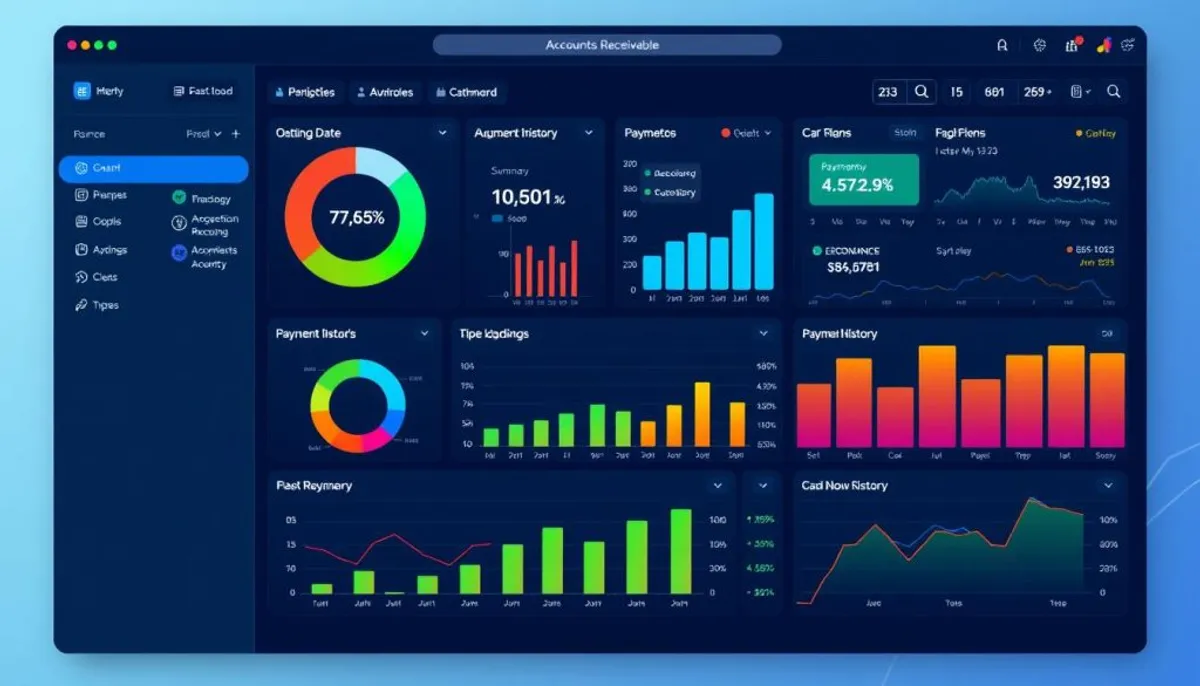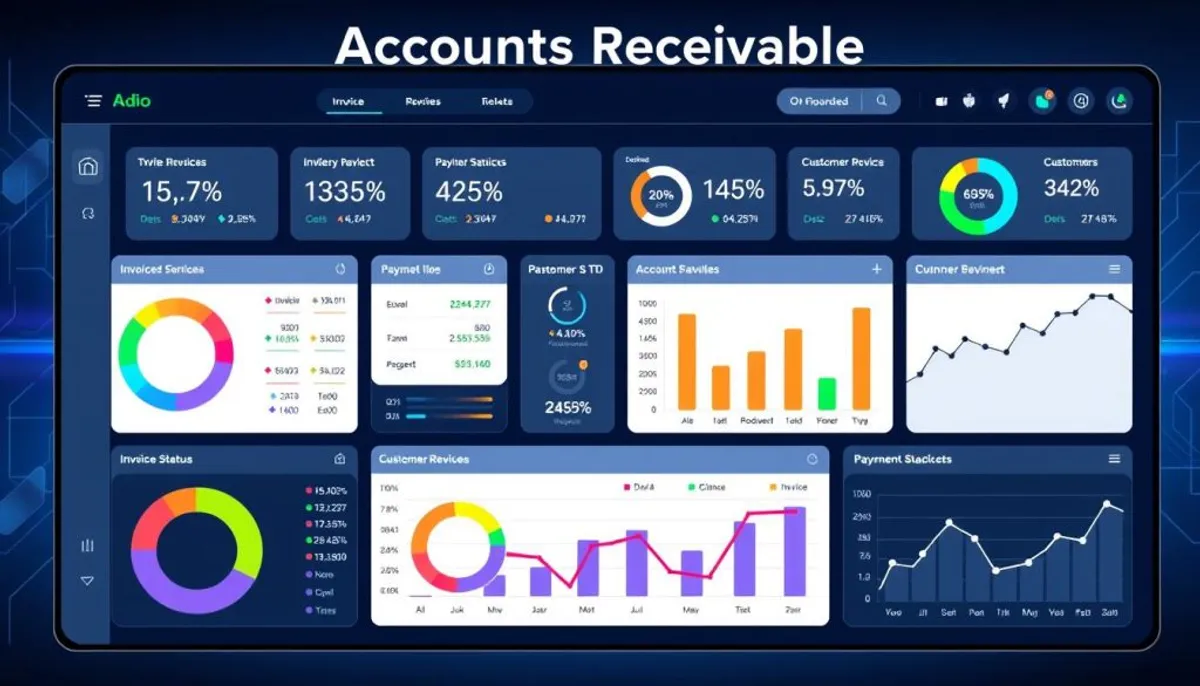Managing your company’s finances has become significantly easier with the advent of accounts receivable accounting software. These tools are transformative for businesses aiming to enhance invoice management and collections tracking. Let’s explore why this software is now indispensable for companies of all sizes.
The days of manually chasing payments are behind us. Modern AR software automates reminders, accelerates payment processing, and provides a transparent view of your cash flow. Renowned options like QuickBooks Online, Xero, and FreshBooks offer robust AR functionalities alongside comprehensive accounting capabilities.

By adopting the right AR software, you can bid farewell to late payments and welcome more efficient operations. These tools facilitate the maintenance of current customer information, expedite dispute resolution, and strike a balance between collection efforts and customer relations. It’s about leveraging technology to optimize your workflow, not to increase your workload.
Key Takeaways
- AR software automates invoice tracking and payment collection
- Popular solutions integrate AR tools with broader accounting functions
- Automated reminders help reduce late payments and improve cash flow
- AR software streamlines dispute resolution and maintains customer relationships
- Choosing the right AR tool can significantly reduce manual data entry errors
Understanding Accounts Receivable Software Fundamentals
Accounts receivable (AR) software has revolutionized the financial landscape for contemporary enterprises. It simplifies customer billing, payment processing, and cash flow forecasting. This innovation is fundamentally altering how businesses manage their finances and interact with their clientele.
What Makes AR Software Essential for Modern Business
In today’s business environment, AR software is indispensable. It addresses a significant hurdle: the issue of late payments. Such delays can severely impact cash flow. AR software empowers companies to monitor and manage payments more efficiently. This results in enhanced financial stability and streamlined operations.
Key Components of AR Management Systems
AR management systems are equipped with vital functionalities. They include automated invoice creation, payment tracking, and reconciliation tools. The software also offers reporting functionalities, providing businesses with detailed financial insights. These elements collectively form a comprehensive AR solution.
Benefits of Automating Accounts Receivable
Automating AR processes offers substantial advantages. It accelerates cash flow by minimizing late payments. The software sends timely reminders to customers, fostering prompt payment behavior. It also diminishes invoicing errors, a costly issue that previously cost companies $53.50 to rectify per error.
AR software provides invaluable data through its reporting tools. Businesses can calculate critical metrics such as the accounts receivable turnover ratio. This metric is crucial for monitoring customer payment speed. A higher ratio indicates quicker payments, enhancing cash flow management.
By adopting AR software, businesses can significantly enhance their financial operations. They achieve better control over customer billing, streamline payment processing, and refine cash flow forecasting. This technology transcends being a mere tool; it serves as a strategic asset for contemporary business success.
Top Features to Look for in Accounts Receivable Accounting Software
Choosing the right accounts receivable software is crucial for streamlining financial operations. Let’s explore key features that make AR software indispensable for modern businesses.
Automated Invoice Generation and Processing
Efficient AR software should offer automated invoice creation and distribution. This feature saves time and reduces errors in the billing process. Look for systems that support paperless billing and automated reminders to improve cash flow.
Payment Processing and Reconciliation Tools
Seamless payment processing is crucial. Top AR software integrates with various payment gateways and automates reconciliation. This functionality ensures accurate financial reporting and timely updates to customer accounts.
Reporting and Analytics Capabilities
Robust financial reporting tools are essential for informed decision-making. Advanced AR software provides real-time insights into cash flow, aging reports, and customer payment trends. These analytics help optimize collections strategies and predict future cash positions.
Integration Capabilities with Existing Systems
The best AR software seamlessly integrates with your current cloud-based accounting systems, CRM, and ERP platforms. This integration ensures data consistency across all financial operations and enhances overall efficiency.
When selecting AR software, consider solutions that offer these key features to maximize the benefits of automation and improve your accounts receivable management.
Leading AR Software Solutions for Small Businesses
Small businesses encounter distinct financial management hurdles. The correct accounts receivable software can significantly enhance operations, improve cash flow, and stimulate expansion. We will examine some premier options designed for small enterprises.
QuickBooks Online Features and Pricing
QuickBooks Online is renowned for its advanced invoice management functionalities. Starting at $35/month, it offers flexible plans for businesses in growth phases. It excels in tracking collections, offering immediate payment status updates. QuickBooks also simplifies billing for customers with customizable invoices and automated payment reminders.
FreshBooks Platform Overview
FreshBooks is tailored for freelancers and small businesses, boasting an intuitive design. Priced at $19/month, it provides cost-effective invoice management tools. It excels in creating and sending professional invoices, and its basic collections tracking aids in maintaining cash flow.
Xero Accounting Capabilities
Xero offers a competitive edge with unlimited users across all plans. Starting at $15/month, it boasts comprehensive invoice management features. Its user-friendly interface for billing and robust collections tracking tools are notable. Small businesses value its seamless integration with numerous third-party applications.

| Software | Starting Price | Key Features |
|---|---|---|
| QuickBooks Online | $35/month | Robust invoice management, real-time insights |
| FreshBooks | $19/month | User-friendly interface, customizable invoices |
| Xero | $15/month | Unlimited users, strong third-party integrations |
Each platform brings unique advantages in invoice management, collections tracking, and customer billing. Small businesses must weigh their specific requirements and budget when selecting the most suitable AR software. This choice is crucial for supporting their financial operations and growth.
Enterprise-Level Accounts Receivable Solutions
Large organizations require advanced accounts receivable accounting software to handle intricate financial tasks. Enterprise-level solutions provide sophisticated features for streamlined processes and enhanced cash flow management.
BlackLine is notable for its comprehensive suite, encompassing cash application, credit risk management, and dispute resolution. SAP S/4HANA offers a cloud-based ERP system with robust AR automation capabilities. HighRadius, on the other hand, provides AI-driven automation tailored for large-scale operations.
These enterprise solutions boast impressive statistics:
- 20% reduction in Days Sales Outstanding (DSO)
- 30% improvement in productivity
- 85% straight-through cash posting achieved
- 98% automated cash application
- $20M recovered from invalid deductions
Enterprise AR software features include multi-entity support, AI-powered analytics, and complex workflow automation. These platforms integrate seamlessly with existing systems, enhancing financial reporting and cloud-based accounting processes.
When selecting enterprise AR software, consider scalability, integration capabilities, and customization options. Pricing for these solutions is typically tailored to specific business needs and scale, reflecting the advanced functionality and support provided.
Cloud-Based vs. On-Premise AR Software Comparison
The decision between cloud-based and on-premise accounting solutions is pivotal for businesses aiming to enhance their accounts receivable management. We will examine the fundamental distinctions and advantages of each method.
Advantages of Cloud-Based Solutions
Cloud-based AR software presents substantial benefits in the contemporary business environment. It enables companies to access their tools from any location, accommodating remote work preferences. This flexibility fosters better collaboration among accounting teams and other departments, leading to enhanced workflow efficiency.
Cloud platforms offer real-time updates, immediate software enhancements, and increased scalability. McKinsey and Company highlight that cloud adoption boosts technology infrastructure ROI by 29% and minimizes downtime during data migration by 57%.
Security Considerations
Despite some organizations preferring on-premise systems for security reasons, cloud-based solutions have significantly improved in data protection. These platforms typically employ robust security features, such as data encryption and regular backups. It is essential to verify compliance with industry standards when choosing a cloud provider.
Cost Comparison Analysis
Cloud-based AR solutions generally demand lower initial costs compared to on-premise alternatives. They eliminate the need for significant hardware investments and reduce IT support requirements. On-premise systems, while granting more control, often require higher initial investments and ongoing maintenance expenses.
| Factor | Cloud-Based | On-Premise |
|---|---|---|
| Initial Investment | Lower | Higher |
| Maintenance Costs | Minimal | Substantial |
| Scalability | High | Limited |
| Accessibility | Anywhere | On-site |
| Updates | Automatic | Manual |
Cloud-based AR software, with features like automated reminders and streamlined payment processing, presents a compelling option for businesses aiming to modernize their accounting practices. The flexibility, scalability, and cost-effectiveness of cloud solutions make them a preferred choice for many organizations.
Introducing ti3: A Modern Solution for AR Management
ti3 introduces a novel approach to managing accounts receivable. This platform excels in handling overdue accounts with unmatched precision and efficiency. It redefines the landscape of AR management.
Automated Payment Reminder System
ti3’s automated reminders streamline the collection process. It sends timely, personalized messages to clients, minimizing manual follow-ups and enhancing cash flow. This feature ensures consistent communication, freeing up your team’s resources.
Collections Process Optimization
ti3 transforms collections tracking. It employs a structured method to manage unpaid accounts, prioritizing cases and escalating issues when necessary. This platform offers a cost-effective alternative to traditional agencies, fostering positive client relationships while increasing collection rates.
Client Relationship Management Features
Beyond collections, ti3 emphasizes nurturing client relationships. It provides tools for tracking interactions, managing disputes, and customizing communication strategies. This approach aids in maintaining robust client connections, even during financially challenging times.
| Feature | Benefit |
|---|---|
| Automated Reminders | Improved cash flow, reduced manual work |
| Collections Tracking | Higher collection rates, cost-effective process |
| Client Management | Stronger client relationships, tailored communication |

ti3 emerges as a comprehensive solution for modern AR management. It combines automated reminders, optimized collections processes, and robust client management features. This empowers businesses to streamline their accounts receivable operations effectively.
Best Practices for AR Software Implementation
Introducing accounts receivable (AR) software into your business can revolutionize your financial operations. To achieve success, adhere to essential practices for managing invoices, processing payments, and generating financial reports.
Begin by establishing clear objectives for your AR system. Engage key stakeholders from accounting, finance, and IT departments. This collaborative effort ensures the software aligns with your organization’s needs and objectives.
Data migration is a critical step. Ensure the accuracy and consistency of transferring existing financial records to the new system. This foundational step is essential for reliable invoice management and financial reporting.
Staff training is paramount for a seamless transition. Offer comprehensive training on creating invoices, processing payments, and generating reports. This empowers your team to maximize the software’s capabilities.
- Set up automated payment reminders to reduce Days Sales Outstanding (DSO)
- Configure the system to track Average Days Delinquent (ADD)
- Utilize reporting tools to monitor Accounts Receivable Turnover Ratio
- Aim for a Collection Effectiveness Index (CEI) close to 100%
Adopt a phased implementation strategy. Begin with fundamental functions like invoice creation and payment processing. Gradually introduce advanced features such as financial reporting and analytics. This approach minimizes disruptions and facilitates smoother transitions.
Regularly review and optimize AR processes post-implementation. Monitor key performance indicators and gather user feedback to continuously enhance your system’s efficiency and effectiveness.
ROI and Cost Considerations for AR Software
Investing in accounts receivable (AR) software can be transformative for businesses. We will explore the financial implications of adopting these solutions.
Initial Investment Requirements
The cost of AR software spans a broad spectrum. Small enterprises can access affordable options starting at $49 monthly. For larger corporations, bespoke solutions might cost between $140,000 and $400,000. Opting for annual payments can yield savings of up to 20%.
Long-term Financial Benefits
The ROI for AR automation can be impressive, reaching up to 390%. Businesses experience notable enhancements:
- 30% increase in timely cash inflow
- 25% reduction in past-due deliverables
- 20% decrease in days sales outstanding (DSO)
- 15% reduction in bad debt reserves
These gains are attributed to better cash flow forecasting and streamlined financial reporting. Cloud-based accounting solutions enhance these benefits by offering real-time data access and fostering collaboration.
Hidden Costs to Consider
While the advantages are evident, hidden costs must be acknowledged:
- Staff training expenses
- System customization fees
- Potential upgrades or scalability costs
- Data migration and integration expenses
Despite these factors, 93% of companies that have digitalized at least half of their AR tasks express satisfaction. The enhanced efficiency, reduced employee stress, and improved customer experience justify the investment for many businesses.
Conclusion
Choosing the appropriate accounts receivable accounting software is transformative for businesses seeking to optimize their financial processes. With midsize organizations leveraging over 100 SaaS applications in 2024, the trend towards software adoption is unmistakable. This shift brings significant advantages, including the potential to save up to 60 hours weekly on invoice management through automation.
Investing in advanced AR software significantly enhances both invoice management and collections tracking. By offering a variety of payment options, businesses can increase conversion rates. Automated systems also help reduce bad debts through timely reminders, thus improving cash flow. The efficiency gains are evident, with automated systems handling disputes and deductions efficiently, ensuring customer satisfaction.
In selecting accounts receivable accounting software, it is crucial to consider your business’s size, industry-specific requirements, and integration capabilities. Regular assessments of AR processes and software performance are essential to maintain operational efficiency. The right software not only enhances cash flow but also provides valuable insights for strategic decision-making. This positions your business for success in the rapidly evolving digital landscape.
RelatedRelated articles



